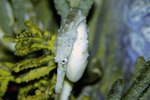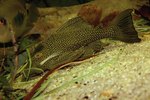
The coral beauty angelfish (Centropyge bispinosa) has a lot going for it. It's much smaller than most angelfish. It also lacks the aggression and picky eating that larger angelfish are known for. It also rarely bothers corals, another plus most angelfish lack.
Tank Setup
Coral beauty angelfish need a large aquarium of at least 55 gallons. They also require lots of rocks, which provide the angelfish with the hiding places they need to feel safe and comfortable. Rocks also provide places for algae to grown, which these little angelfish can nibble on. Coral beauty angelfish work well in both fish-only aquariums and reef tanks, though live rock -- dead coral skeletons colonized by marine life -- is preferred in either case.
Water Chemistry
Like most tropical saltwater aquarium fish, the coral beauty requires very specific conditions, unlike many freshwater fish. The water pH must remain between 8.1 and 8.4. They also must have a specific gravity between 1.019 and 1.025. Lastly, the temperature must stay between 74 and 82 degrees Fahrenheit. Most importantly, coral beauty angelfish require clean water, so keep up on your water changes in order to maintain this species in good health.
Tankmates
Coral beauty angelfish get along well with most other fish. Your main concern is picking fish that will not pick on the coral beauties. The one exception is that these angelfish may get aggressive among their own kind. Males in particular may fight. If you want to minimize aggression, add coral beauties to the tank at the same time, since they are most likely to pick on newcomers. Male-female pairs tend to get along well. This species also rarely bothers corals. However, individual specimens have been known to occasionally pick at certain soft corals, like Xenia polyps.
Feeding
Coral beauty angelfish are omnivores that lean toward a vegetarian diet. In a tank, they will graze on algae on rocks constantly. They will also readily take frozen preparations intended for herbivores, which you can find at high-end pet shops. Coral beauties do like some animal-based foods in their diet and love frozen mysid shrimp and finely grated seafoods. Feed animal-based foods as the occasional treat and plant-based foods as the primary staple.
References
Photo Credits
-
Jupiterimages/Photos.com/Getty Images




